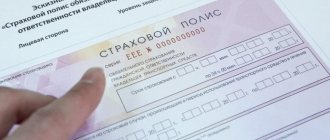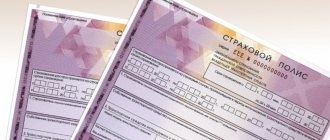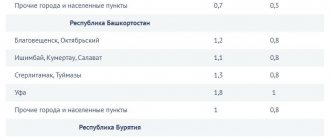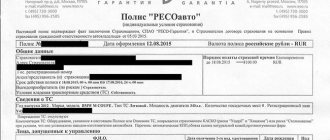How much does OSAGO cost in 2018?
So, first we will explain how the calculation of the insurance premium (the one that is paid when purchasing a policy) works in accordance with the rules of OSAGO.
- There is a base rate in the form of a price range that the insurance companies themselves have the right to set (but more often maximum values are set),
- And there are coefficients that depend on the data of the drivers allowed to drive and the parameters of the car and which are applied in turn to the base tariff by multiplying the latter by these coefficients.
The increase in the cost of compulsory motor liability insurance this time is due to an increase in the base tariff (in fact, the corridor is simply increasing), as well as several coefficients applied to the base tariff.
The final price of the policy is calculated using the following formulas:
- for passenger cars of individuals : basic tariff x territorial coefficient (region of registration of the owner) x bonus-malus coefficient (accident-free driving) x limited/unlimited insurance x vehicle power x seasonality of use x number of violations in the previous insurance period;
- for passenger cars of legal entities : basic tariff x territorial coefficient (region of registration of the owner) x bonus-malus coefficient (accident-free driving) x age/experience of approved drivers x limited/unlimited insurance x vehicle power x seasonality of use x number of violations in the previous insurance period x availability of a trailer;
- for motorcycles and trucks of individuals : basic tariff x territorial coefficient (region of registration of the owner) x bonus-malus coefficient (accident-free driving) x age/experience of approved drivers x limited/unlimited insurance x seasonality of use x number of violations in the previous insurance period x availability trailer;
- for motorcycles and trucks of individuals : basic tariff x territorial coefficient (region of registration of the owner) x bonus-malus coefficient (accident-free driving) x limited/unlimited insurance x seasonality of use x number of violations in the previous insurance period x availability of a trailer.
A small addition has appeared in the MTPL calculation forums - this is the coefficient of the number of violations. Previously, it was not applied, but at the new rates it will be applied and will always be equal to 1.5 if there were violations of the insurance rules in the previous period:
- if the driver knowingly provided false information when applying for insurance, which affected the reduction in the cost of the policy,
- if the driver deliberately staged an accident or lied about damage information,
- if the driver has been presented with a recourse claim.
So, now let's move directly to the numbers, and in the “was/has become” format we will present all the changes in insurance rates and coefficients!
You will also be interested in:
- OSAGO 2021 – what’s new and what changes?
- How much more expensive will OSAGO insurance be after an accident?
- What changes are being made to compulsory motor liability insurance from April 1, 2021? Will insurance become more expensive?
How is compulsory motor liability insurance calculated using the formula?
The calculations are based on the basic insurance rate, which is multiplied by various variables that affect the final cost of the policy.
Such factors include the driving experience of the potential policyholder, his age, type, class and make of the car, its date of manufacture, degree of wear of parts, engine power, territory of use, etc.
Of no small importance is the purpose of using the car and the number of people allowed to drive it. Thus, vehicles used in commercial activities (for example, for cargo transportation, taxis) are insured at an increased rate, so insurance for such a vehicle will cost several times more than a standard policy.
Below is the formula for calculating compulsory motor liability insurance in 2021. With its help, it is possible to determine the amount of insurance premium for a specific car, taking into account various variables.
TB * KO * KS * CT * KM * KVS * KN * KBM = T
In this algorithm, the listed components have the following meanings:
- T – final price of the insurance premium;
- TB – the size of the basic tariff;
- KO – the value of the limiting coefficient, the indicators of which depend on the number of drivers who have access to the car;
- KS – seasonality coefficient, that is, the period of use of transport;
- CT – the value of the territorial coefficient (we are talking about taking into account the region in which the owner of the vehicle is registered);
- KM - coefficient responsible for the power of the car engine (accounting is carried out in horsepower);
- КН – coefficient, the value of which depends on the presence or absence of any traffic violations in the driver’s past;
- KVS is a coefficient that takes into account the age of the driver of the insured vehicle and his driving experience;
- KBM is the “bonus-malus” coefficient, reflecting the presence of insured events that occurred in the past due to the fault of the person indicated in the insurance.
Insurance companies undertake to use this formula for compulsory motor liability insurance in 2021, therefore they do not have the right to unreasonably inflate the price of the policy.
Increasing the basic MTPL tariff
Here, as we already mentioned above, in 2021 it was not the tariff itself that increased, but the range of possible prices applied by insurers for these tariffs.
| Transport category | Was | It became |
| Motorcycles and scooters (A and M) | 867-1579 | 694-1407 |
| Passenger cars (B and BE) of individuals | 3432-4118 | 2746-4942 |
| Passenger cars (B and BE) of legal entities | 2573-3087 | 2058-2911 |
| Passenger cars (B and BE) taxis | 5138-6166 | 4110-7399 |
| Trucks (C and CE) with a permissible weight of 16 tons | 3509-4211 | 2807-5053 |
| Trucks (C and CE) with a permissible weight of more than 16 tons | 5284-6341 | 4227-7609 |
As you can see, in the basic tariffs, the increase in compulsory motor liability insurance affected only the most popular categories of vehicles: passenger cars. persons, taxi drivers and trucks.
What to do in case of an accident in 2021
The algorithm of actions in case of an accident is standard:
- if there are victims, you must immediately call an ambulance;
- call the traffic police;
- notify the insurance company about the accident and follow its instructions.
The situation can be resolved without the involvement of authorized bodies. To do this, at least one of the following conditions must be met:
- no one was injured as a result of the accident;
- both sides agree on who exactly is responsible for what happened;
- both parties do not want to document the accident.
At the same time, they can draw up a European protocol. This is done in the following cases:
- no more than 2 parties were involved in the accident;
- each of the participants in the accident has an insurance document;
- there is no disagreement between them;
- no one was killed, and no one else's property was damaged.
There are several rules for filling out such a protocol:
- a ballpoint pen is used;
- All necessary information about the participants is entered into the document;
- the front part is filled out by each of the parties, after which it is certified with signatures (2 from each);
- the reverse side does not remain blank;
- if changes are subsequently made to the document, they are confirmed by signatures;
- completed copies are separated.
The document, drawn up in accordance with all the rules, is submitted to the insurer within 5 days after the accident occurred. It must be accompanied by all required documents, the list of which is determined by the insurance company itself.
Region of residence coefficient
It is correctly called the “territorial coefficient”. And this coefficient was not affected by the increase.
Show odds table
| Region of transport use | Coefficient |
| Republic of Adygea | 1,3 |
| Altai Republic | |
| Gorno-Altaisk | 1,3 |
| Other cities and towns | 0,7 |
| Republic of Bashkortostan | |
| Blagoveshchensk, Oktyabrsky | 1,2 |
| Ishimbay, Kumertau, Salavat | 1,1 |
| Sterlitamak, Tuymazy | 1,3 |
| Ufa | 1,8 |
| Other cities and towns | 1 |
| The Republic of Buryatia | |
| Ulan-Ude | 1,3 |
| Other cities and towns | 0,6 |
| The Republic of Dagestan | |
| Buynaksk, Derbent, Kaspiysk, Makhachkala, Khasavyurt | 0,7 |
| Other cities and towns | 0,6 |
| The Republic of Ingushetia | |
| Malgobek | 0,8 |
| Nazran | 0,6 |
| Other cities and towns | 0,6 |
| Kabardino-Balkarian Republic | |
| Nalchik, Prokhladny | 1 |
| Other cities and towns | 0,7 |
| Republic of Kalmykia | |
| Elista | 1,3 |
| Other cities and towns | 0,6 |
| Karachay-Cherkess Republic | 1 |
| Republic of Karelia | |
| Petrozavodsk | 1,3 |
| Other cities and towns | 0,8 |
| Komi Republic | |
| Syktyvkar | 1,6 |
| Ukhta | 1,3 |
| Other cities and towns | 1 |
| Republic of Crimea | |
| Simferopol | 0,6 |
| Other cities and towns | 0,6 |
| Mari El Republic | |
| Volzhsk | 1 |
| Yoshkar-Ola | 1,4 |
| Other cities and towns | 0,7 |
| The Republic of Mordovia | |
| Ruzaevka | 1,2 |
| Saransk | 1,5 |
| Other cities and towns | 0,8 |
| The Republic of Sakha (Yakutia) | |
| Neryungri | 0,8 |
| Yakutsk | 1,2 |
| Other cities and towns | 0,6 |
| Republic of North Ossetia-Alania | |
| Vladikavkaz | 1 |
| Other cities and towns | 0,8 |
| Republic of Tatarstan | |
| Almetyevsk, Zelenodolsk, Nizhnekamsk | 1,3 |
| Bugulma, Leninogorsk, Chistopol | 1 |
| Elabuga | 1,2 |
| Kazan | 2 |
| Naberezhnye Chelny | 1,7 |
| Other cities and towns | 1,1 |
| Tyva Republic | |
| Kyzyl | 0,6 |
| Other cities and towns | 0,6 |
| Udmurt republic | |
| Votkinsk | 1,1 |
| Glazov, Sarapul | 1 |
| Izhevsk | 1,6 |
| Other cities and towns | 0,8 |
| The Republic of Khakassia | |
| Abakan, Sayanogorsk, Chernogorsk | 1 |
| Other cities and towns | 0,6 |
| Chechen Republic | 0,6 |
| Chuvash Republic | |
| Kanash | 1,1 |
| Novocheboksarsk | 1,2 |
| Cheboksary | 1,7 |
| Other cities and towns | 0,8 |
| Altai region | |
| Barnaul | 1,7 |
| Biysk | 1,2 |
| Zarinsk, Novoaltaisk, Rubtsovsk | 1,1 |
| Other cities and towns | 0,7 |
| Transbaikal region | |
| Krasnokamensk | 0,6 |
| Chita | 0,7 |
| Other cities and towns | 0,6 |
| Kamchatka Krai | |
| Petropavlovsk-Kamchatsky | 1,3 |
| Other cities and towns | 1 |
| Krasnodar region | |
| Anapa, Gelendzhik | 1,3 |
| Armavir, Sochi, Tuapse | 1,2 |
| Belorechensk, Yeisk, Kropotkin, Krymsk, Kurganinsk, Labinsk, Slavyansk-on-Kubani, Timashevsk, Tikhoretsk | 1,1 |
| Krasnodar, Novorossiysk | 1,8 |
| Other cities and towns | 1 |
| Krasnoyarsk region | |
| Achinsk, Zelenogorsk | 1,1 |
| Zheleznogorsk, Norilsk | 1,3 |
| Kansk, Lesosibirsk, Minusinsk, Nazarovo | 1 |
| Krasnoyarsk | 1,8 |
| Other cities and towns | 0,9 |
| Perm region | |
| Berezniki, Krasnokamsk | 1,3 |
| Lysva, Tchaikovsky | 1 |
| Permian | 2 |
| Solikamsk | 1,2 |
| Other cities and towns | 1,1 |
| Primorsky Krai | |
| Arsenyev, Artem, Nakhodka, SpasskDalniy, Ussuriysk | 1 |
| Vladivostok | 1,4 |
| Other cities and towns | 0,7 |
| Stavropol region | |
| Budennovsk, Georgievsk, Essentuki, Mineralnye Vody, Nevinnomyssk, Pyatigorsk | 1 |
| Kislovodsk, Mikhailovsk, Stavropol | 1,2 |
| Other cities and towns | 0,7 |
| Khabarovsk region | |
| Amursk | 1 |
| Komsomolsk-on-Amur | 1,3 |
| Khabarovsk | 1,7 |
| Other cities and towns | 0,8 |
| Amur region | |
| Belogorsk, Svobodny | 1,1 |
| Blagoveshchensk | 1,6 |
| Other cities and towns | 1 |
| Arhangelsk region | |
| Arkhangelsk | 1,8 |
| Kotlas | 1,6 |
| Severodvinsk | 1,7 |
| Other cities and towns | 0,85 |
| Astrakhan region | |
| Astrakhan | 1,4 |
| Other cities and towns | 0,8 |
| Belgorod region | |
| Belgorod | 1,3 |
| Gubkin, Stary Oskol | 1 |
| Other cities and towns | 0,8 |
| Bryansk region | |
| Bryansk | 1,5 |
| Klintsy | 1 |
| Other cities and towns | 0,7 |
| Vladimir region | |
| Vladimir | 1,6 |
| Gus-Khrustalny | 1,1 |
| Moore | 1,2 |
| Other cities and towns | 1 |
| Volgograd region | |
| Volgograd | 1,3 |
| Volzhsky | 1,1 |
| Kamyshin, Mikhailovka | 1 |
| Other cities and towns | 0,7 |
| Vologda Region | |
| Vologda | 1,7 |
| Cherepovets | 1,8 |
| Other cities and towns | 0,9 |
| Voronezh region | |
| Borisoglebsk, Liski, Rossosh | 1,1 |
| Voronezh | 1,5 |
| Other cities and towns | 0,8 |
| Ivanovo region | |
| Ivanovo | 1,8 |
| Kineshma | 1,1 |
| Shuya | 1 |
| Other cities and towns | 0,9 |
| Irkutsk region | |
| Angarsk | 1,2 |
| Bratsk, Tulun, Ust-Ilimsk, Ust-Kut, Cheremkhovo | 1 |
| Irkutsk | 1,7 |
| Usolye-Sibirskoye | 1,1 |
| Shelekhov | 1,3 |
| Other cities and towns | 0,8 |
| Kaliningrad region | |
| Kaliningrad | 1,1 |
| Other cities and towns | 0,8 |
| Kaluga region | |
| Kaluga | 1,2 |
| Obninsk | 1,3 |
| Other cities and towns | 0,9 |
| Kemerovo region | |
| Anzhero-Sudzhensk, Kiselevsk, Yurga | 1,2 |
| Belovo, Berezovsky, Mezhdurechensk, Osinniki, Prokopyevsk | 1,3 |
| Kemerovo | 1,9 |
| Novokuznetsk | 1,8 |
| Other cities and towns | 1,1 |
| Kirov region | |
| Kirov | 1,4 |
| Kirovo-Chepetsk | 1,2 |
| Other cities and towns | 0,8 |
| Kostroma region | |
| Kostroma | 1,3 |
| Other cities and towns | 0,7 |
| Kurgan region | |
| Mound | 1,4 |
| Shadrinsk | 1,1 |
| Other cities and towns | 0,6 |
| Kursk region | |
| Zheleznogorsk | 1 |
| Kursk | 1,2 |
| Other cities and towns | 0,7 |
| Leningrad region | 1,3 |
| Lipetsk region | |
| Dace | 1 |
| Lipetsk | 1,5 |
| Other cities and towns | 0,8 |
| Magadan Region | |
| Magadan | 0,7 |
| Other cities and towns | 0,6 |
| Moscow region | 1,7 |
| Murmansk region | |
| Apatity, Monchegorsk | 1,3 |
| Murmansk | 2,1 |
| Severomorsk | 1,6 |
| Other cities and towns | 1,2 |
| Nizhny Novgorod Region | |
| Arzamas, Vyksa, Sarov | 1,1 |
| Balakhna, Bor, Dzerzhinsk | 1,3 |
| Kstovo | 1,2 |
| Nizhny Novgorod | 1,8 |
| Other cities and towns | 1 |
| Novgorod region | |
| Borovichi | 1 |
| Velikiy Novgorod | 1,3 |
| Other cities and towns | 0,9 |
| Novosibirsk region | |
| Berdsk | 1,3 |
| Iskitim | 1,2 |
| Kuibyshev | 1 |
| Novosibirsk | 1,7 |
| Other cities and towns | 0,9 |
| Omsk region | |
| Omsk | 1,6 |
| Other cities and towns | 0,9 |
| Orenburg region | |
| Buguruslan, Buzuluk, Novotroitsk | 1 |
| Orenburg | 1,7 |
| Orsk | 1,1 |
| Other cities and towns | 0,8 |
| Oryol Region | |
| Livny, Mtsensk | 1 |
| Eagle | 1,2 |
| Other cities and towns | 0,7 |
| Penza region | |
| Zarechny | 1,2 |
| Kuznetsk | 1 |
| Penza | 1,4 |
| Other cities and towns | 0,7 |
| Pskov region | |
| Velikie Luki | 1 |
| Pskov | 1,2 |
| Other cities and towns | 0,7 |
| Rostov region | |
| Azov | 1,2 |
| Bataysk | 1,3 |
| Volgodonsk, Gukovo, Kamensk-Shakhtinsky, Novocherkassk, Novoshakhtinsk, Salsk, Taganrog | 1 |
| Rostov-on-Don | 1,8 |
| Mines | 1,1 |
| Other cities and towns | 0,8 |
| Ryazan Oblast | |
| Ryazan | 1,4 |
| Other cities and towns | 0,9 |
| Samara Region | |
| Novokuybyshevsk, Syzran | 1,1 |
| Samara | 1,6 |
| Tolyatti | 1,5 |
| Chapaevsk | 1,2 |
| Other cities and towns | 0,9 |
| Saratov region | |
| Balakovo, Balashov, Volsk | 1 |
| Saratov | 1,6 |
| Engels | 1,2 |
| Other cities and towns | 0,7 |
| Sakhalin region | |
| Yuzhno-Sakhalinsk | 1,5 |
| Other cities and towns | 0,9 |
| Sverdlovsk region | |
| Asbest, Revda | 1,1 |
| Berezovsky, Verkhnyaya Pyshma, Novouralsk, Pervouralsk | 1,3 |
| Verkhnyaya Salda, Polevskoy | 1,2 |
| Ekaterinburg | 1,8 |
| Other cities and towns | 1 |
| Smolensk region | |
| Vyazma, Roslavl, Safonovo, Yartsevo | 1 |
| Smolensk | 1,2 |
| Other cities and towns | 0,7 |
| Tambov Region | |
| Michurinsk | 1 |
| Tambov | 1,2 |
| Other cities and towns | 0,8 |
| Tver region | |
| Vyshny Volochek, Kimry, Rzhev | 1 |
| Tver | 1,5 |
| Other cities and towns | 0,8 |
| Tomsk region | |
| Seversk | 1,2 |
| Tomsk | 1,6 |
| Other cities and towns | 0,9 |
| Tula region | |
| Aleksin, Efremov, Novomoskovsk | 1 |
| Tula | 1,5 |
| Uzlovaya, Shchekino | 1,2 |
| Other cities and towns | 0,9 |
| Tyumen region | |
| Tobolsk | 1,3 |
| Tyumen | 2 |
| Other cities and towns | 1,1 |
| Ulyanovsk region | |
| Dimitrovgrad | 1,2 |
| Ulyanovsk | 1,5 |
| Other cities and towns | 0,9 |
| Chelyabinsk region | |
| Zlatoust, Miass | 1,4 |
| Kopeisk | 1,6 |
| Magnitogorsk | 1,8 |
| Satka, Chebarkul | 1,2 |
| Chelyabinsk | 2,1 |
| Other cities and towns | 1 |
| Yaroslavl region | |
| Yaroslavl | 1,5 |
| Other cities and towns | 0,9 |
| Moscow | 2 |
| Saint Petersburg | 1,8 |
| Sevastopol | 0,6 |
| Jewish Autonomous Region | |
| Birobidzhan | 0,6 |
| Other cities and towns | 0,6 |
| Nenets Autonomous Okrug | 0,8 |
| Khanty-Mansiysk Autonomous Okrug - Ugra | |
| Kogalym | 1 |
| Nefteyugansk, Nyagan | 1,3 |
| Surgut | 2 |
| Nizhnevartovsk | 1,8 |
| Khanty-Mansiysk | 1,5 |
| Other cities and towns | 1,1 |
| Chukotka Autonomous Okrug | 0,6 |
| Yamalo-Nenets Autonomous Okrug | |
| New Urengoy | 1 |
| Noyabrsk | 1,7 |
| Other cities and towns | 1,1 |
| Baikonur | 0,6 |
If the owner of the car is a foreigner and has temporarily entered the territory of Russia, then a single territorial coefficient of 1.7 is applied to him.
Are the rules for compensation under compulsory motor liability insurance changing?
Here the answer is yes, and the changes are significant. Thus, at present, in accordance with the decision of the Constitutional Court on compulsory motor liability insurance, the injured driver is awarded only part of the compensation for harm. He will have to demand the rest from the driver who caused him the damage. The Constitutional Court of the Russian Federation determined that the amount paid under compulsory motor liability insurance is not full compensation for damage to the vehicle, adjusted for wear and tear. Thus, the owner of the damaged car certainly does not receive compensation in full. This violates his property rights.
At the same time, the insurer pays fairly in accordance with the standards established for it, and there is no reason to demand more from it. In these conditions, the remaining liability for the obligation falls on the driver who is at fault in the accident.
The disadvantage of this step is that now the perpetrator is not fully protected by insurance, although in essence it represents an agreement under which he has no obligations in relation to the victim in the event of an accident due to his fault.
KBM
The bonus-malus coefficient also remains unchanged, and an increase in compulsory motor liability insurance in this part is not expected until at least the end of 2019, but from January 1, 2021, only the “cosmetic part” changes - the name of the accident-free driving class will not be used, but simply indicated coefficient.
Was:
Became:
Calculate the cost of your MTPL policy
Table of new MTPL tariffs for 2021
The project assumes that the basic tariff corridor for policies will be simultaneously expanded by 20% down and up for all categories of vehicles. Exceptions will be motorcycles (for them - 10.9%) and passenger cars of legal entities (5.7%). Thus, for vehicles of individuals in category “B”, the basic values will range from 2746 to 4942 rubles, for legal entities in the same category - 2058-2911 rubles, for motorcycles and scooters - 649-1407 rubles.
It is also planned to reform the system of discounts and allowances for accident-free driving, the bonus-malus coefficient (BMC). The KBM is expected to be changed from January 1, 2021, after which the insurance history will be assigned to each driver. If the driver had a break in driving, the insurance history will not be reset. In addition, the number of coefficients taking into account the age and experience of the driver will be increased.
The project must be approved by the Board of Directors of the Central Bank. The document will come into force 10 days after this.
The Central Bank of Russia has published for public discussion a draft instruction on the maximum size of base rates for compulsory motor liability insurance. In addition, it specifies the coefficients of insurance premiums, as well as the procedure for their application to insurers.
It is noted that this is the first step in the tariff reform in OSAGO previously announced by the Central Bank. As the first stage of the reform, it is proposed to expand the base tariff corridor for passenger cars owned by individuals. It is also expected that policies for owners of motorcycles and scooters will become cheaper.
Other changes include reforming the discount for accident-free driving and the surcharge for accidents. As expected, the regulator plans to switch to an annual calculation procedure.
It is expected that comments on the draft instructions will be accepted by the Central Bank by June 20.
The Central Bank of Russia has published a draft that determines the procedure for changing the maximum amounts of base rates and insurance tariff coefficients for compulsory motor liability insurance, as well as the procedure for their application by insurance companies when determining insurance premiums.
As noted, this is the first step in the previously announced reform of MTPL tariffs.
To begin with, it is planned to expand the base tariff corridor for passenger cars of individuals by 20% down and up. Thus, the maximum rate will increase from 4118 rubles to 4942 rubles, the minimum rate will be reduced from 3432 to 2746 rubles.
For passenger cars of legal entities and motorcycles, policies will become cheaper: the upper limit will decrease by 5.7% (to 2,911 rubles) and 10.9% (to 1,047 rubles), respectively.
The Central Bank will leave the territorial coefficients unchanged.
In addition, the number of coefficients that take into account the age and experience of drivers will be increased.
The reform will also affect the system of discounts and allowances for accident-free driving, the bonus-malus coefficient (BMC).
After its change (from January 1, 2021), the insurance history will be assigned to each driver. While now both the driver and the owner of the vehicle can have different KBM. At the same time, there will be no cases of resetting your insurance history due to a long break in driving.
So far, the published document has only draft status and has not yet been approved by the leadership of the Central Bank.
On June 8, the Ministry of Finance announced that the Russian authorities will be able to completely abandon the regulation of MTPL tariffs in five years. At the same time, the process of liberalization of policies will take place in two stages: first, a gradual transition from mandatory coefficients to voluntary ones, so that insurance companies can set the coefficients themselves, then an expansion of the tariff corridor with a gradual abandonment of tariff regulation in general.
Increasing the cost of an unlimited OSAGO policy
According to the coefficient of the number of persons admitted to management, an increase in the insurance rate is also expected, but only if your policy is unlimited.
| Limited or unlimited OSAGO policy | The coefficient was | The coefficient has become |
| Limited | 1 | 1 |
| Unlimited | 1,8 | 1,87 |
And for legal entities, the policy limitation coefficient is the same - 1.8.
What are the changes to the MTPL policy? (QR code, KBM)
At the same time, in appearance, the policy was visibly updated. In 2021, it will be issued on new forms.
Now this document has a QR code measuring 2x2 centimeters in the upper right corner. This makes it possible to immediately establish that this document is real. In addition, the details contain information about the contract itself.
It is possible to scan this element if you have a smartphone that has the corresponding utility. Next, the portal of the Russian Union of Auto Insurers opens on this device, from which pages with basic contract data will be downloaded, including:
- insurance contract number;
- information about the car;
- duration of the agreement.
In this case, such a QR code will be present exclusively on pink papers issued on the premises of the insurance company. If the policyholder chose to receive the form by mail, it will be sent to him without such details.
There is also innovation regarding the bonus-malus coefficient. The updated form for 2021 shows the class at the time the coverage began. It also contains a table that shows the classes for all drivers in a situation where, under insurance, a clearly defined circle of people has the right to drive a vehicle. In this way, the transaction price is calculated in a completely understandable manner.
In other words, having information on how to calculate the accident-free class and knowing the coefficients in force in his constituent entity of the Russian Federation, any driver will be able to determine whether he was told the correct figure for the price of his insurance.
If the insurance is issued with the condition that any person can drive the car, then the new policy will include a field where the class of the owner himself is written at the time the contract was drawn up.
Increasing the age and experience coefficient
It is this part of calculating the cost of compulsory motor liability insurance that has undergone serious changes. And an increase here is also to be expected. Changes have occurred in terms of gradation of age and experience - if previously there were only 2 of them: younger and older than 22 years, less and more than 3 years of experience, now there will be more variations.
Was:
| Age and experience of drivers | Coefficient |
| Age up to 22 years and experience up to 3 years | 1,8 |
| Age over 22 years and experience up to 3 years | 1,7 |
| Age up to 22 years and experience more than 3 years | 1,6 |
| Age over 22 years and experience more than 3 years | 1 |
And here are the new coefficients based on the age and length of service of eligible drivers.
Something else useful for you:
- How much does it cost to include a driver in MTPL insurance?
- Changes in the rules for drawing up the European protocol from September 13, 2019
- Is it possible to register a car with the MFC today and how? Instructions
Changes to the inspection procedure in 2021
There are no fundamental changes in technical inspection issues. The cost of such a service (today a technical inspection costs from 800 to 1,500 rubles) will increase. The legislation provides for the installation of cameras to monitor the quality of technical inspections.
There are no changes regarding technical inspection for pensioners. This is due to the fact that older people in Russia rarely drive. If a pensioner does not have enough funds to conduct a technical inspection, such a service will be provided to him free of charge. Official dealers are still responsible for its implementation.










